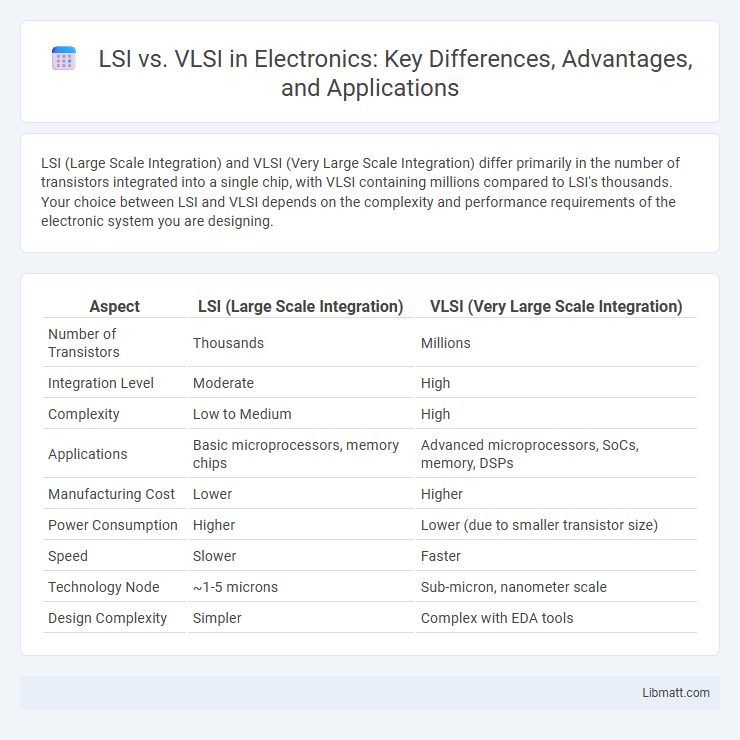LSI (Large Scale Integration) and VLSI (Very Large Scale Integration) differ primarily in the number of transistors integrated into a single chip, with VLSI containing millions compared to LSI's thousands. Your choice between LSI and VLSI depends on the complexity and performance requirements of the electronic system you are designing.
Table of Comparison
| Aspect | LSI (Large Scale Integration) | VLSI (Very Large Scale Integration) |
|---|---|---|
| Number of Transistors | Thousands | Millions |
| Integration Level | Moderate | High |
| Complexity | Low to Medium | High |
| Applications | Basic microprocessors, memory chips | Advanced microprocessors, SoCs, memory, DSPs |
| Manufacturing Cost | Lower | Higher |
| Power Consumption | Higher | Lower (due to smaller transistor size) |
| Speed | Slower | Faster |
| Technology Node | ~1-5 microns | Sub-micron, nanometer scale |
| Design Complexity | Simpler | Complex with EDA tools |
Introduction to LSI and VLSI
LSI (Large Scale Integration) and VLSI (Very Large Scale Integration) represent key advancements in semiconductor technology, enabling the integration of thousands to millions of transistors on a single chip. LSI typically integrates thousands of transistors, ideal for mid-complexity circuits, while VLSI incorporates hundreds of thousands to millions, supporting highly complex microprocessors and memory chips. Your choice between LSI and VLSI depends on the scale and complexity of the integrated circuit needed for your electronic design.
Definition of LSI (Large Scale Integration)
LSI (Large Scale Integration) refers to the process of integrating thousands of transistors into a single silicon chip, enabling more complex and powerful circuits compared to earlier technologies like SSI and MSI. It marked a significant advancement in semiconductor technology, allowing for more functionality within a smaller physical space, which is crucial in modern electronic devices. Your understanding of LSI is essential for grasping the evolution toward VLSI (Very Large Scale Integration), where millions of transistors are integrated on a chip.
Definition of VLSI (Very Large Scale Integration)
VLSI (Very Large Scale Integration) refers to the technology of integrating thousands to millions of transistors onto a single semiconductor chip, enabling the creation of complex circuits and microprocessors. Unlike LSI (Large Scale Integration), which integrates thousands of components, VLSI dramatically increases the chip density, improving performance and functionality while reducing size and power consumption. Your understanding of VLSI technology is crucial for advancements in modern electronics, including smartphones, computers, and embedded systems.
Key Differences Between LSI and VLSI
Large Scale Integration (LSI) involves integrating thousands of transistors on a single chip, while Very Large Scale Integration (VLSI) integrates millions of transistors, enabling more complex and powerful circuits. LSI chips are typically used in simpler applications like microprocessors and memory modules, whereas VLSI chips support advanced functionalities in modern computers, smartphones, and embedded systems. The scale of integration directly impacts processing speed, power consumption, and chip size, with VLSI offering significant improvements over LSI in all these aspects.
Evolution from LSI to VLSI Technology
The evolution from Large-Scale Integration (LSI) to Very Large-Scale Integration (VLSI) technology marked a significant leap in semiconductor design, enabling the integration of thousands to millions of transistors on a single chip. This advancement exponentially increased computing power, reduced physical chip size, and lowered manufacturing costs, driving rapid innovation in consumer electronics and computing devices. Your technology solutions benefit from this progression by leveraging the enhanced complexity and performance that VLSI offers over LSI.
Applications of LSI in Electronics
LSI (Large-Scale Integration) technology is widely used in the design of microprocessors, memory chips, and digital signal processors, enabling compact and efficient electronic devices. Key applications include embedded systems in consumer electronics, automotive control units, and telecommunications equipment, where moderate complexity circuits are essential. LSI enables integration of thousands of transistors on a single chip, striking a balance between performance and cost for various electronic applications.
Applications of VLSI in Modern Devices
VLSI technology enables the integration of millions of transistors on a single chip, powering modern devices such as smartphones, laptops, and advanced medical equipment. Its application in microprocessors and memory chips drives high performance and energy efficiency essential for artificial intelligence and IoT systems. Your reliance on VLSI circuits ensures faster processing speeds and improved device miniaturization for cutting-edge electronics.
Advantages and Disadvantages of LSI
Large-Scale Integration (LSI) technology allows the packing of thousands of transistors on a single chip, enabling cost-effective production and simplified circuit design compared to earlier methods. However, LSI faces limitations in speed, power consumption, and scalability when compared to Very Large-Scale Integration (VLSI), which accommodates millions of transistors with enhanced performance and complexity. Your choice between LSI and VLSI depends on the specific application requirements, budget constraints, and desired device capabilities.
Advantages and Disadvantages of VLSI
VLSI (Very Large Scale Integration) integrates millions of transistors on a single chip, enabling more compact, faster, and power-efficient electronic devices compared to LSI (Large Scale Integration). The primary advantages of VLSI include higher circuit density, reduced manufacturing cost per component, and enhanced performance in microprocessors and memory chips. However, VLSI faces challenges such as increased design complexity, higher fabrication costs, and difficulties in heat dissipation and testing due to the dense integration of components.
Future Trends in Integrated Circuit Integration
Future trends in integrated circuit integration highlight the shift from Large Scale Integration (LSI) to Very Large Scale Integration (VLSI), driven by the demand for higher transistor density and enhanced performance. VLSI technology enables the incorporation of millions of transistors on a single chip, facilitating advanced functionalities and complex system designs in compact forms. Innovations such as 3D IC stacking, nanometer-scale fabrication, and integration of AI accelerators are poised to redefine future semiconductor architectures beyond traditional LSI capabilities.
LSI vs VLSI Infographic

 libmatt.com
libmatt.com